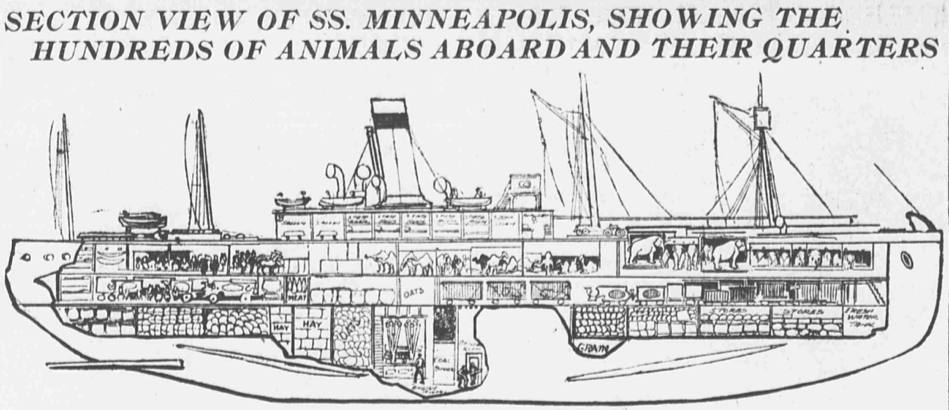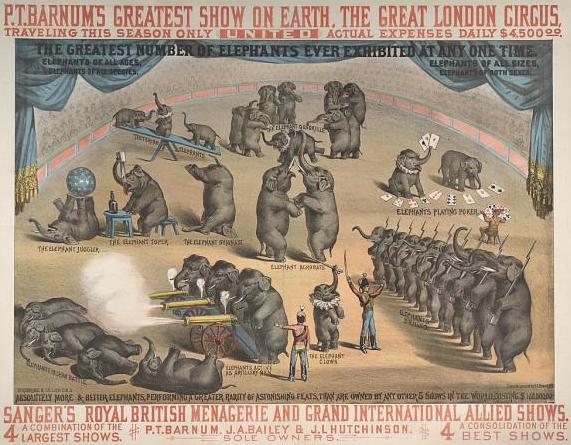One of the things that I referred to in the op-ed I had published over the weekend was the public execution of the elephant Mandarin, which occurred in November 1902. It happened shortly after the Barnum & Bailey Circus arrived aboard the S.S. Minneapolis, docking at Pier 40 on Manhattan’s west side. The circus had been on an extended tour through Europe, and just before departing London, Mandarin struck and killed a keeper with his trunk. He was unruly throughout the crossing, and owner James Bailey decided to have him killed rather than risk Mandarin killing or injuring another worker or the other animals. When the circus steamed into New York Harbor, the Evening World sensationally reported that there was a “MAD ELEPHANT” rampaging onboard and helpfully provided a sketch of the ship for readers.

Four years earlier, the circus had departed for Europe with a herd of eighteen elephants. A photograph on Buckles Blog shows the herd of ten large and eight small elephants. Six of them, including all four big males, died during the tour.

George Conklin (1845-1924) was a lion tamer and elephant trainer who served as the “Superintendent of Animals” for the Barnum & Bailey Circus while it was abroad. His memoir as recorded by journalist Harvey W. Root was published by Harper & Row in 1921 as The Ways of the Circus: Being the Memories and of George Conklin Tamer of Lions. Conklin believed that choking was the “easiest and most humane” way to put down an elephant. In his account of the tour, he describes how a rope and block system was first used to kill Don Pedro at Liverpool in May 1898 after he became aggressive. On the last day of that initial touring season at Stoke-on-Trent, another male Asian elephant named Nick was strangled after becoming unruly. The largest of the elephants, Fritz, was killed after going on a rampage in Tours, France. It was only with much luck that Conklin was able to get him chained to a tree, and a hundred men pulled for fifteen minutes before he was finally choked to death. Fritz’s body was donated to the Musee de Beaux Arts, where it is still on display today.
Last but not least was of course Mandarin. Conklin’s rather laconic account of the killing of the elephant is as follows:
Mandarin was about forty-five years old, all of eight feet high, and heavy in proportion. We brought him to New York in a big crate on the upper deck of the boat. On the way over, Mr. Bailey decided to have him killed, so instead of unloading him on to the pier, Mr. Bailey had a big seagoing tug come alongside, and the crate, elephant and all, was swung down to the deck of the tug, which then put out to sea. When far enough outside the crate was loaded down with pig iron, swung out over the water, and let go. And so ended Mandarin (131).
The New York Tribune, on the other hand, provided a much more sensational account of the proceedings in its November 9 edition. Mandarin, with “head cased in leather harnesses,” and “trunk and legs manacled with huge chains,” was slowly strangled to death on the deck of the ship using a two-inch thick hawser (rope) and windlass. The article also suggests why Conklin’s account was terse, observing that: “George Conklin, the trainer, who had made an especial pet of Mandarin, could not witness the elephant’s end. He watched the preparations, but just before the time for the execution burst into tears and ran away.” A crowd of spectators watched from the docks as the elephant was choked to death; it took about eight minutes and seemed “painless” to the reporter on hand. The next morning Mandarin’s body was disemboweled on deck with “his comrades trumpeting the while,” and then loaded onto another ship, weighted down with lead, and dumped out at sea.
Though less infamous than the electrocution of Topsy at Coney Island or the hanging of the elephant Mary in Kingsport, Tennessee, Mandarin’s execution was an instructive example of the way that the contemporary circus industry valued profits over the welfare of its animals. But part of what makes “The Elephant People” chapter of Conklin’s book so fascinating is that he so clearly cares for the elephants, even as he describes doing things that most modern observers would undoubtedly find troubling. Ideas about what constitutes the humane treatment of animals have simply changed over the last century, and this is what has made the use (and abuse) of wild animals in commercial entertainment increasingly problematic.

It took over half a century for elephants to become integrated into the circus in the United States, and it was not until the late nineteenth century that herds of performing elephants like the one advertised above became common (for a penetrating historical analysis of this process, see Susan Nance’s Entertaining Elephants: Animal Agency and the Business of the American Circus). As the fortunes of the circus in the United States declined over the course of the twentieth century, so did the use of elephants, and the circus revival of recent decades has been driven almost exclusively by shows that have abandoned traditional wild animal acts. Clearly something akin to the public execution of Mandarin is unlikely to happen today, and the episode serves as an apt illustration of the way ideas about animal welfare in the United States have evolved. Now it is up to the American circus industry to fully catch up.
